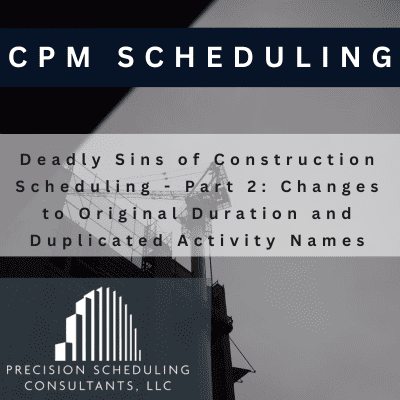The Deadly Sins of Construction Scheduling
The “Deadly Sins of Construction Scheduling” series spotlights common errors I’ve encountered throughout my career as a scheduler, schedule analyst/reviewer, and claims expert. These mistakes can significantly affect the credibility of the schedule and the project’s overall success. Below, I outline two major pitfalls to avoid: changes to original durations and duplicate activity names.
Changes to Original Duration
First, let’s discuss the original duration of activities. Project managers often calculate this duration based on several critical variables. These variables include:
- The scope or quantity of work.
- The number of crew hours estimated for the task.
- Previously established productivity rates.
Once the team establishes the original duration, it should remain unchanged unless significant changes occur in either the scope of work or the resources assigned to it. For instance, if you scale up the project or introduce new crew members, reassessing the duration could be necessary. However, altering the duration without these changes can lead to misunderstandings and misrepresentations of project timelines.
In short, maintaining the integrity of the original duration ensures accurate tracking and accountability throughout the project’s lifecycle.
Duplicate Activity Names
Next, let’s examine the issue of duplicate activity names. Many construction projects involve repetitive work, such as multiple building floors or sections of roadwork. To streamline scheduling, it’s common to copy and paste activity sections for similar tasks with minor adjustments based on scope variations.
However, one frequent oversight occurs when project teams fail to rename duplicated activities. While it might seem trivial, this error can create major complications during updates. For example, incorrect updates may arise because team members mistakenly identify similar activities. Additionally, confusion can mount among reviewers working with the schedule who cannot differentiate between similarly named tasks.
Consequently, the team may need to cross-reference different pages in the construction schedule to determine each activity’s specific work area, leading to inefficiencies. In more complex projects, summarizing activities into tables or reports becomes challenging, resulting in inaccurate data representation.
To avoid these issues, always append the corresponding work area or its abbreviation to duplicate activity names. This practice ensures clarity and eliminates confusion about which activities refer to specific work areas. Clear and distinct naming conventions enhance transparency and make the scheduling process much smoother.
Close Out
In summary, recognizing and addressing these common errors, such as changes to original durations and duplicate activity names, can significantly enhance project scheduling outcomes. By maintaining consistent naming practices and preserving the integrity of original activity durations, project teams can foster greater accuracy, improve communication, and ensure overall project success.
Avoiding these deadly sins will pave the way for streamlined scheduling, clearer project goals, and ultimately, successful project completion. Encourage your team to prioritize these aspects to enhance scheduling


